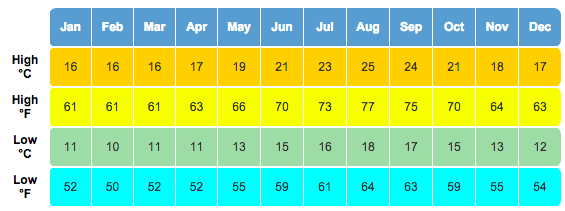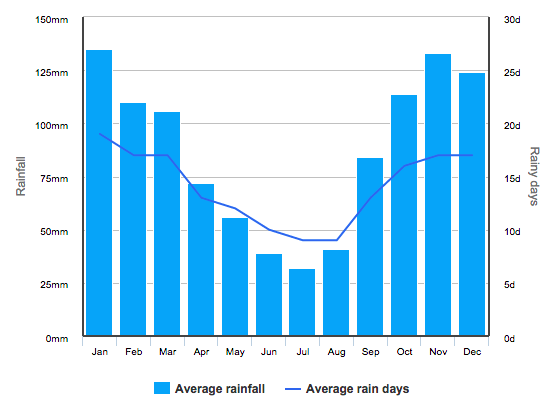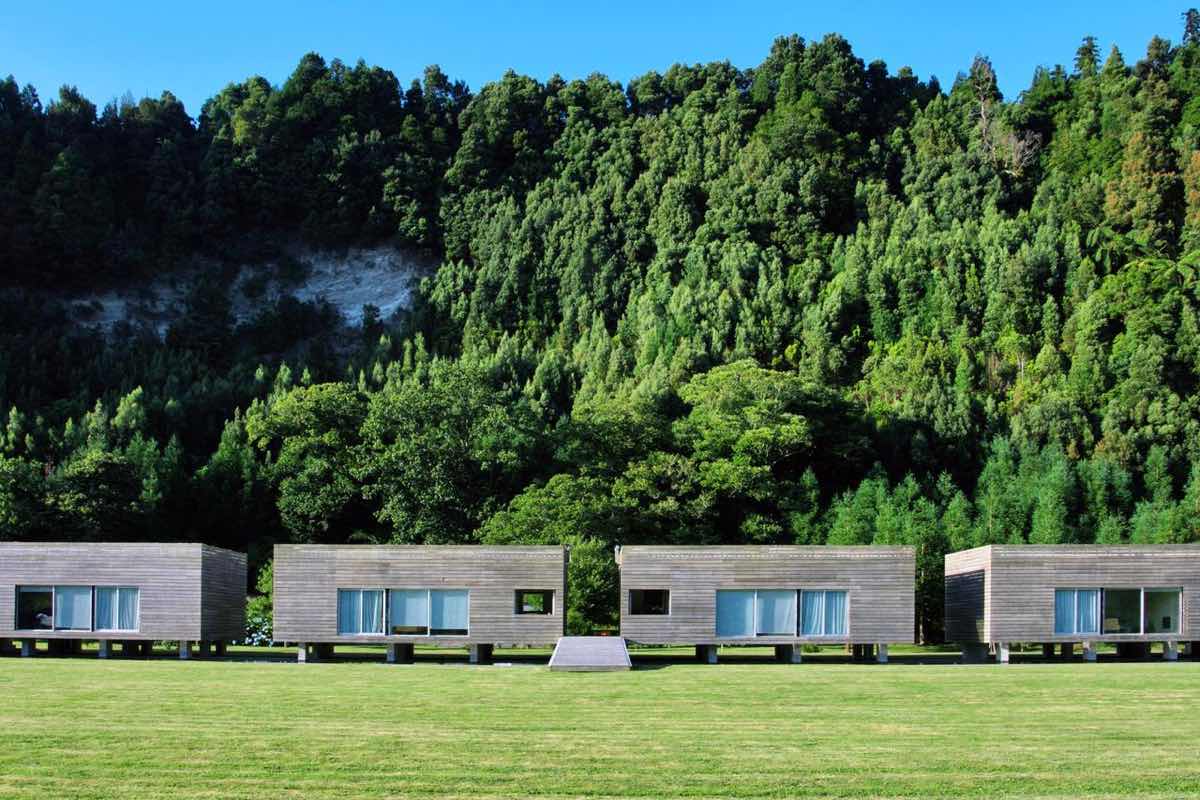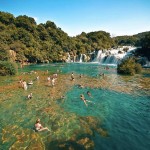The main characteristic of azorean weather is its unpredictability: it can be sunny and hot, windy and strong showers – all in the same day!
Weather & Climate in Azores
The Azores have a maritime subtropical climate across all islands.
While they are located at the same latitude of the Mediterranean Sea, the Atlantic Ocean makes temperatures to go much milder throughout the year. Expect moderate temperatures in summer months – rarely surpassing 30°C/86°F – and rarely dropping below 8°C/47°F during winter time.
The yearly average temperature is a comfortable 17ºC/63ºF. But the humidity can be considerably high (average of 70-80%) in Azores, so it can feel like a lot hotter!
Don’t expect a sunny tropical paradise. In fact, the weather tends to be mostly cloudy during most days, specially during the period from November to March.
Best time to visit the Azores
For most people, the best time to visit the Azores islands is either April-June or September-October. The weather is hard to predict during these times, but fewer crowds guarantee a better experience to immerse yourself in nature.
However, this ultimately depends on what you are interested in doing in the islands in the first place. Here’s a more complete page to help you decide.
More about the weather in Azores:
Temperature in Azores

- The average monthly temperatures only vary 8.1 °C (14.6°F) which is a extremely low range.
- August is the warmest month (22ºC/71ºF on average) while
February is the coldest month (mean temperature of 13ºC/57ºF)
Rainfall

Rainfall is frequent in the Azores, particularly during fall and winter months (October-March). The western-most islands, Flores and Corvo, are specially prone to heavy rains and storms.
On the positive side, this is exactly why all the greenery landscapes are so lush and vivid!
- Ponta Delgada, São Miguel island, has an average of 1026 mm (40.4 inches) of rainfall per year, or 85.5 mm (3.4 inches) per month
- On average it rains in 188 days of the year – days with more than 0.1 mm (0.004 in) of rainfall
- January is the wettest month (133mm) and July the driest (30mm)
Sea Temperature

The ocean in the archipelago is warmed by the Gulf Stream and it can reach temperatures of 24ºC/75ºF at the summer peak.
- August and September are the months with warmest sea water, while January to April are the coolest
Azores weather by month
January-February
Taking into account all the statistics above, it is clear you can’t expect great weather from winter months – these are the coldest and wettest months of the year. This period can be harsh in the Azores islands, particularly Flores and Corvo where wind and rain can potentially be quite severe. Flight cancellations are likely.
Overall, expect foggy, rainy, and even stormy days to be frequent in Azores in January and February. Keep in mind when planning for outdoor activities. On the plus side, these months see the fewer number of tourists, so you get the stunning landscapes pratically for yourself.
- January is the wettest month of the year (average of 133mm of rain)
- February is the coldest month of the year (average of 13ºC/55ºF)
March-April
Weather slowly starts to shift. Days are longer, temperatures are higher, flowers start to bloom. That said, this is still a period of high instability with ever-changing weather phenomena at its peak. This is a good time if you’re into whale-watching, as it’s the period when the most species can be seen off the Azorean coast.
May-June
Expect mild pleasant weather. Showers are common but often only last a few minutes, before the sun shines again. June can already have some very warm days, suited for an ocean swim. Great time for photographers, as the landscapes are greener and flowers have bloomed, including the fabulous hydrangeas (June-July).
July-August
It’s peak summer time in Azores! ☀️ You can expect more hours of sunshine, and the hottest sunny days. Come during this time if you want to maximize the chances of clear days, but know that comes with a price: more crowds. In some sights, namely in São Miguel, can start to feel overcrowded, taking away the beauty of the landscapes.
- July is the driest month of the year (only 30mm of rainfall)
- August is the hottest month of the year (average of 22ºC/72ºF) and also the month with most daily sunshine hours (9) of the year
September-October
The longtail of the summer sees crowds slowly start to wander off. Locals only move around the island to beaches and sights on weekends. It’s the best time of the year to swim in the ocean, with sea temperatures at its peak.
However, October is also peak hurricane season in the North Atlantic Ocean. Over the years, and with climate change, more of these have hit the Azores, so don’t be surprised if weather alerts are issued.
- September is the month when ocean temperature is the highest (24ºC/75ºF)
November-December
Water is all around – it’s the time of the year where the weather is rainy, humid, foggy. But still quite unstable – don’t be surprised if you get to experience warm sun, heavy rain and wind, all in a single day!
- December is the month with the least amount of sunshine hours (5) of the year
Book your hotel in Azores ASAP for the best deal!
I’ve made your life easier and you can start your search with my pre-selection of the hotels/guesthouses/villas in the Azores. This list only includes the top-rated reviewed hotels in the islands, with WiFi included. Hard to go wrong with these!
Pre-filtered list of hotels with top reviews and location with parking and free WiFi included.
More about the Azores:
My articles about the Azores
- The Ultimate Itinerary of São Miguel Island (Made By An Azorean)
- The Top Azores Hot Springs & Thermal Baths in Sao Miguel
- Furnas, Azores: Unique things to do in the Furnas Valley
- Ponta Delgada, Azores: 12 Things To Do In My Hometown
- The 13 Most Beautiful Azores Beaches
- When Is The Best Time to Go To Azores?
- Hiking in Azores: An Insider Guide
- São Miguel, Azores: Full Travel Guide by a Local
- The Best Hotels in São Miguel, Azores For All Kinds Of Travelers
- Azores: 20 Travel Tips To Know Before You Go


















